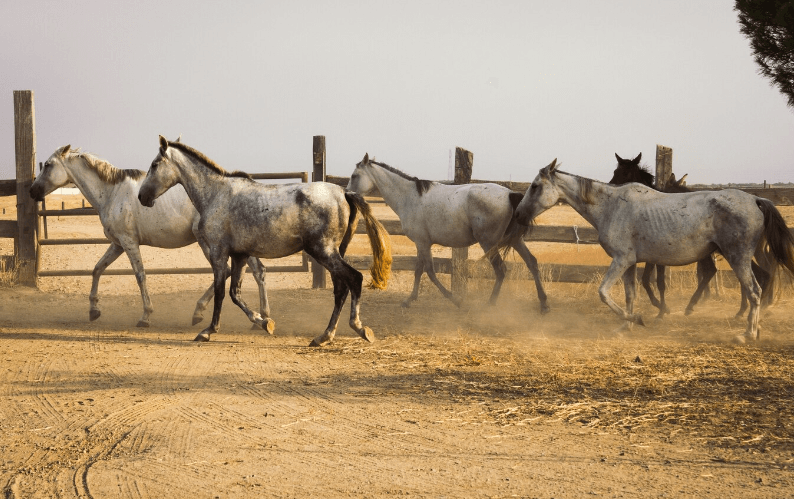Arabian Horses—The Ancient and Elegant Breed Pressed by Centuries

Arabian horses are one of the most ancient and revered breeds in the world. With a history dating back thousands of years, these majestic creatures have captured the hearts and imaginations of people throughout history. Renowned for their elegance, beauty, and incredible endurance, Arabian horses continue to be beloved and admired by equestrian enthusiasts around the globe.
The Arabian horse is known for its distinctive physical characteristics, including a dished face, high-set tail, and delicately curved neck. These features not only contribute to their unique and elegant appearance but also enhance their performance in various disciplines, such as dressage, endurance riding, and show jumping.
But it is not just their physical attributes that make Arabian horses stand out. Their exceptional intelligence, loyalty, and gentle nature have also earned them a well-deserved reputation as one of the most trainable and versatile horse breeds. Whether they are serving as trusted companions for children and adults or competing in high-level equestrian competitions, Arabian horses consistently demonstrate their innate talent, grace, and agility.
Content:
The Arabian Horse: History and Characteristics
The Arabian horse is an ancient and elegant breed that has a rich history dating back thousands of years. It is believed to have originated on the Arabian Peninsula and is one of the oldest horse breeds in the world.
Known for its beauty and grace, the Arabian horse is easily recognizable with its dished face, high tail carriage, and finely chiseled head. It has a compact body and is known for its endurance and agility.
The Arabian horse has played a significant role in the development of many other breeds, lending its elegance and refined features to create new types of horses. Its influence can be seen in various disciplines, including racing, endurance riding, and showing.
One of the most remarkable characteristics of the Arabian horse is its loyalty and strong bond with humans. They are known for their intelligence and willingness to please, making them highly trainable and versatile.
Arabian horses have a unique genetic makeup, with a high percentage of fast-twitch muscle fibers that allow them to excel in speed and agility. They have a natural ability for long-distance travel and have been used as war horses, desert travelers, and racing animals.
Today, Arabian horses continue to captivate equestrians and horse lovers around the world with their beauty, elegance, and incredible athleticism. Whether they are competing in prestigious horse shows or serving as beloved companions, the Arabian horse remains a symbol of ancient heritage and unmatched grace.
Arabian horses, celebrated for their ancient lineage and elegant beauty, have captivated equestrians and horse lovers for centuries with their grace and endurance. This breed’s storied past and distinctive characteristics highlight the diverse tapestry of the equine world. In exploring this diversity, the American Saddlebred breed also stands out as a notable example of American equine heritage, known for its versatility, spirited personality, and the unique role it has played in American history. Together, Arabian and American Saddlebred horses showcase the rich variety and cultural significance of horse breeds around the globe.
The Origins of Arabian Horses
The Arabian horse is an ancient breed known for its elegance and unique characteristics. This breed has a rich history and is considered one of the oldest horse breeds in the world. The origins of Arabian horses can be traced back thousands of years to the Arabian Peninsula, specifically the regions of Arabia, Mesopotamia, and Egypt.
The ancient Arabian horses were highly valued by the Bedouin tribes who bred them for their endurance, speed, and beauty. These horses played a crucial role in the Bedouin way of life, being used for transportation, warfare, and as a symbol of wealth and prestige. The Bedouin tribes carefully preserved the purity of the Arabian breed through strict breeding practices, ensuring that these horses maintained their unique characteristics.
Arabian horses are known for their distinctive physical features, such as a dished face, arched neck, and high tail carriage. These features are believed to have evolved as adaptations to the harsh desert environment in which they originated. The small, dished face helped these horses breathe easily in sandy conditions, while the arched neck and high tail carriage allowed them to move gracefully and efficiently.
The Arabian breed also has a reputation for intelligence, loyalty, and a spirited yet gentle nature. These traits have made Arabian horses popular not only as riding and show horses but also as valuable breeding stock. Arabian bloodlines can be found in many modern horse breeds, as their influence has been widely recognized and respected.
Arabian Horses Today
Today, Arabian horses are cherished by horse enthusiasts all over the world. They continue to be highly regarded for their beauty, athleticism, and versatility. Arabian horse shows and competitions are held worldwide, showcasing the breed’s excellence in various disciplines such as racing, endurance riding, dressage, and show jumping.
Preserving the Arabian Breed
Efforts are being made to preserve and protect the Arabian breed, as their numbers have declined over the years. Organizations such as the Arabian Horse Association work to promote responsible breeding practices and maintain the breed’s genetic diversity. These efforts ensure that future generations can continue to appreciate and enjoy the ancient and elegant Arabian horses.
| Ancient Origins | Distinctive Features | Enduring Legacy |
|---|---|---|
| The Arabian breed has ancient origins dating back thousands of years to the Arabian Peninsula. | Arabian horses are known for their distinctive physical features, such as a dished face and arched neck. | The Arabian breed’s legacy lives on in modern horse breeds, showcasing their influence and importance. |
| The Bedouin tribes meticulously preserved the purity of the Arabian breed through strict breeding practices. | The unique features of Arabian horses are believed to have evolved as adaptations to the desert environment. | The intelligence, loyalty, and gentle nature of Arabian horses continue to be valued by enthusiasts worldwide. |
The Unique Characteristics of Arabian Horses
Arabian horses are a breed of ancient origins, known for their distinct characteristics that set them apart from other horse breeds.
1. Exquisite Beauty
Arabian horses are often described as the most beautiful of all horse breeds. They have a dished face, large expressive eyes, and a high-set tail that adds to their elegance.
2. Endurance and Stamina
Arabian horses are renowned for their exceptional stamina and endurance. They have evolved to thrive in the harsh desert environment, where they were used as war horses and for long-distance travel.
These horses possess a unique lung capacity that allows them to endure long rides without tiring easily.
3. Intelligence and Trainability
Arabian horses are known for their intelligence and trainability. They are quick learners and have a strong desire to please their handlers. This makes them highly adaptable to various equestrian disciplines.
Overall, Arabian horses have a combination of ancient grace, endurance, and intelligence that makes them a truly remarkable breed.
The Significance of Arabian Horses in History
Arabian horses are a breed that has stood the test of time, with their ancient lineage dating back thousands of years. These majestic creatures have played a significant role throughout history, making them a truly remarkable and influential breed.
The Arabian horse has been a faithful companion to humans for centuries, with evidence of their existence dating as far back as 2500 BC. Their endurance, speed, and beauty made them highly sought after and valued by ancient civilizations.
One of the most significant contributions of the Arabian horse to history is its impact on the development of other horse breeds. Through trade and conquest, Arabian horses were spread across the world, influencing and improving the genetic pool of many other breeds. Their characteristics, such as their dished profile, high tail carriage, and strong bones, have left an indelible mark on countless horse breeds today.
Arabian horses also played a vital role in warfare throughout history. Their agility, intelligence, and courage were highly valued by warriors and conquerors. From the sands of the Arabian Peninsula to the battlefields of ancient Egypt and beyond, Arabian horses played a crucial role in the success of various armies.
Furthermore, Arabian horses have long been associated with nobility, wealth, and prestige. They were often given as gifts between royalty and influential figures, cementing their status as a symbol of power and luxury. Their elegance and beauty captivated the hearts of many, turning them into objects of desire and admiration.
Today, the significance of Arabian horses in history can still be seen in various equestrian disciplines. Their versatility and athleticism have made them highly successful in horse racing, endurance riding, and dressage. The Arabian breed continues to captivate horse lovers around the world, serving as a testament to their enduring legacy.
In conclusion, the Arabian horse holds a special place in the annals of history. Their ancient lineage and remarkable traits have made them a breed of great significance. From their influence on other horse breeds to their role in warfare and their association with prestige, Arabian horses have left an indelible mark on human history.
The Arabian Horse in Arabic Culture
The Arabian horse holds a significant place in Arabic culture, as it is considered both a symbol of beauty and a source of pride. This ancient breed has been treasured by Arabic tribes for centuries, and its origins can be traced back to the Arabian Peninsula. The Bedouins, a nomadic Arab people, relied heavily on Arabian horses for transportation and warfare.
In Arabic culture, Arabian horses are often associated with nobility and power. They are known for their grace, endurance, and loyalty, making them highly valued by Arabian rulers and warriors. These horses are also linked to the concept of “asalah”, which means purity and authenticity. Arabian horses are considered to be a pure breed, with their bloodline carefully preserved and documented over generations.
Arabian horses are frequently featured in Arabic folklore, literature, and art. They are celebrated for their beauty, with their dainty heads, arched necks, and expressive eyes captivating the imagination of artists and poets alike. The Arabian horse is often depicted in Arabic paintings, tapestries, and sculptures, serving as a symbol of elegance and sophistication.
In addition to their cultural significance, Arabian horses continue to excel in equestrian sports around the world. Their natural athleticism and agility make them well-suited for disciplines such as endurance riding and dressage. Many Arabian horses have achieved great success in international competitions, further cementing their place in the history and culture of Arabic horsemanship.
The Arabian Horse’s Role in Endurance Riding
The Arabian horse breed, known for its ancient history and elegant appearance, boasts a long-standing reputation for excelling in endurance riding. Endurance riding is a sport that tests the horse and rider’s stamina, versatility, and teamwork over long distances and challenging terrains.
Endurance riding, typically spanning distances of 50 to 100 miles, requires horses with exceptional endurance, agility, and strength. Arabian horses have proven to be well-suited for this demanding sport due to their natural abilities and unique physiological attributes.
Exceptional Endurance
Arabian horses are renowned for their exceptional endurance capabilities. In the harsh desert environments of the Arabian Peninsula, these horses were bred and developed to withstand long treks without water or rest.
The breed’s efficient cardiorespiratory system contributes to its remarkable endurance. Their large nostrils, expansive lung capacity, and efficient circulation allow Arabian horses to take in and process oxygen efficiently, enabling them to maintain sustained performance over extended periods.
Agility and Versatility
In addition to their impressive endurance, Arabian horses possess impeccable agility and versatility. These qualities enable them to navigate through various terrains encountered in endurance riding competitions, including mountains, deserts, and forests.
With their natural athleticism and nimble footwork, Arabian horses can tackle steep inclines, cross rivers, and traverse uneven terrain with ease. These skills allow riders to cover long distances swiftly and safely, optimizing their performance in endurance riding events.
Overall, the Arabian horse’s role in endurance riding can be attributed to its breed’s remarkable endurance, agility, and versatility. Whether competing in endurance rides or embarking on long-distance journeys, Arabian horses continue to impress riders and spectators alike with their ancient lineage and elegant performance in this demanding sport.
The Arabian Horse’s Contribution to Horse Racing
The Arabian horse breed has made a significant contribution to the world of horse racing. These magnificent horses with their elegant and graceful build have long been known for their speed and endurance, making them highly sought after for racing.
Ancient Origins of Arabian Horses in Racing
The Arabian horse has a rich history in the world of horse racing, with its origins dating back thousands of years. In ancient times, Arabian horses were prized for their ability to outrun other breeds, making them the preferred choice for horse racing events.
Influence on Modern Thoroughbred Racing
The influence of Arabian horses on modern thoroughbred racing cannot be overstated. In the 18th and 19th centuries, Arabian bloodlines were crossed with European horse breeds to improve their speed and stamina. This infusion of Arabian blood revolutionized the sport of horse racing, resulting in the creation of the modern thoroughbred breed.
Even today, Arabian bloodlines continue to have a significant impact on the world of horse racing. Many top racehorses can trace their ancestry back to Arabian horses, which is a testament to the enduring influence of this ancient and elegant breed.
The Arabian Horse’s Popularity as a Show Horse
Arabian horses have long been recognized as one of the most elegant and regal breeds in the world. Their distinctive beauty and graceful movements have made them highly sought after in the world of show horses.
Arabian horses are known for their refined features, including a dished face, large expressive eyes, and a high-set tail. These characteristics, combined with their slender yet strong build, make them a sight to behold in the show ring.
Arabian horses excel in a variety of disciplines, including dressage, jumping, endurance riding, and halter classes. Their natural athleticism and willingness to work make them versatile performers and crowd favorites.
One of the reasons Arabian horses are popular show horses is their ability to form strong bonds with their handlers. Their intelligent and friendly nature make them easy to train and work with, creating a harmonious partnership in the show ring.
Their beauty and elegance also contribute to their popularity as show horses. Arabian horses’ graceful movements and flowing manes and tails captivate audiences and judges alike.
In addition to their physical attributes, Arabian horses have a rich history and cultural significance that adds to their appeal as show horses. They are one of the oldest horse breeds in the world, with a lineage that can be traced back thousands of years.
Arabian horses have been prized by Bedouin tribes for their strength, endurance, and loyalty, and they continue to embody these qualities today. Their reputation as a symbol of nobility and grace makes them highly sought after by equestrians and enthusiasts around the world.
Overall, the Arabian horse’s popularity as a show horse can be attributed to its combination of beauty, athleticism, intelligence, and cultural significance. Whether they are competing in dressage, jumping, or halter classes, Arabian horses consistently capture the hearts and attention of audiences everywhere.
Modern Preservation and Breeding of Arabian Horses
The ancient breed of Arabian horses has captivated the hearts of horse enthusiasts for centuries. With their graceful movements, beautiful physique, and incredible endurance, these horses have become a symbol of elegance and power. Today, efforts are being made to preserve and breed the Arabian horse, ensuring that this magnificent breed continues to thrive for future generations.
Preservation of the Arabian horse involves a combination of careful breeding and rigorous bloodline tracking. Breeders meticulously select horses with desirable traits, such as a dished face, arched neck, and high tail carriage. By breeding horses with these characteristics, breeders aim to maintain the breed’s unique features and preserve its ancient lineage.
A significant aspect of preserving Arabian horses is the establishment of stud books. These books document the ancestry of every registered horse, helping breeders make informed decisions about breeding pairs. The stud books ensure that the breed remains pure and free from any crossbreeding, which could dilute its distinctive qualities.
In addition to preserving the breed, modern breeding practices are also focused on enhancing its overall health and performance. Through genetic testing and advanced veterinary care, breeders can identify any potential health issues in horses and take necessary steps to address them. This ensures that Arabian horses stay strong, resilient, and capable of enduring the challenges of various disciplines, from racing to endurance riding.
Furthermore, the use of artificial insemination and embryo transfer techniques has revolutionized the breeding process, allowing breeders to expand their breeding programs and access a wider range of genetic material. This has helped maintain and improve the quality of Arabian horses, ensuring that the breed continues to evolve and adapt to the changing demands of the equine world.
Modern preservation and breeding practices are essential to ensuring the continued existence of the ancient Arabian horse breed. By carefully selecting breeding pairs, maintaining accurate pedigree records, and incorporating scientific advancements, breeders strive to preserve the essence of this magnificent and iconic breed. Through their dedicated efforts, the Arabian horse will continue to enchant and inspire horse lovers around the world for generations to come.
The Arabian Horse’s Influence on Other Horse Breeds
The ancient and elegant Arabian breed has had a significant influence on the development of other horse breeds throughout history. Renowned for their beauty, endurance, and intelligence, Arabian horses have been highly sought after and admired by horse enthusiasts worldwide.
Enhanced Stamina and Endurance
One of the key aspects that Arabian horses have imparted on other breeds is their exceptional stamina and endurance. This ancient breed has been bred for thousands of years in harsh desert conditions, resulting in horses that can travel long distances without tiring. This characteristic has been essential in improving the endurance of other horse breeds, particularly in long-distance riding and racing competitions.
Refined Physical Characteristics
The elegant appearance and refined physical characteristics of Arabian horses have influenced the aesthetics of numerous other horse breeds. Arabians are known for their graceful neck and distinctive head shape, with a concave profile and large, expressive eyes. These features have been highly admired and sought after, leading to the incorporation of Arabian traits in various breeds to enhance their overall appearance and appeal.
| Characteristic | Influence on Other Breeds |
|---|---|
| Graceful Neck | Implemented in breeds such as the Thoroughbred and Andalusian to enhance their elegance. |
| Distinctive Head Shape | Influenced the profiles of breeds like the Lipizzaner, Friesian, and Appaloosa for a more refined appearance. |
| Expressive Eyes | Sought after in horse breeds such as the Arabian crossbreeds for a more engaging and alert expression. |
The Arabian horse’s influence on other breeds extends beyond physical traits. Their intelligence, versatility, and willingness to please have also been coveted qualities adopted in numerous horse breeding programs. From eventing to dressage, Arabian bloodlines can be found in various equestrian disciplines and have contributed to the success and ability of many modern-day horse breeds.
In conclusion, the ancient and elegant Arabian horse breed has played a significant role in shaping and improving other breeds throughout history. From enhanced stamina and endurance to refined physical characteristics and versatile traits, Arabian horses have left a lasting impression on the world of horse breeding. Their influence continues to be appreciated and celebrated by equestrians worldwide.
Caring for Arabian Horses: Tips and Considerations
The ancient and elegant breed of Arabian horses requires special care and attention to ensure their health and well-being. These magnificent creatures have been prized for centuries for their beauty, endurance, and intelligence. Here are some important tips and considerations for caring for Arabian horses:
1. Nutrition:
Proper nutrition is crucial for the overall health and longevity of Arabian horses. A well-balanced diet should consist of high-quality hay or pasture grass, supplemented with grain and protein-rich feeds. It is important to provide fresh water at all times and monitor the horse’s weight and condition to adjust the feeding regimen accordingly.
2. Exercise and Training:
Arabian horses are known for their incredible endurance and agility. Regular exercise is essential to maintain their physical and mental well-being. A combination of riding, lunging, and ground training can help keep Arabian horses fit and engaged. It’s important to gradually increase the intensity and duration of exercise to avoid injuries and strain.
3. Grooming and Maintenance:
The elegant appearance of Arabian horses requires regular and thorough grooming. This includes brushing the coat, mane, and tail to remove dirt and tangles. Additionally, routine hoof care, such as trimming and cleaning, is necessary to prevent discomfort and hoof-related issues. Regular veterinary check-ups and vaccinations are also vital for maintaining the horse’s health.
4. Shelter and Environment:
Providing a suitable shelter and environment is crucial for the well-being of Arabian horses. They require access to a well-ventilated barn or shelter to protect them from extreme weather conditions. Ample turnout time in a safe and secure pasture is also important for their physical and mental stimulation. Regular cleaning and maintenance of the stable and pasture are essential to prevent disease and ensure cleanliness.
5. Socialization and Companionship:
Arabian horses are social animals and thrive on companionship. It is important to provide them with opportunities for socialization and interaction with other horses. If a horse is kept alone, it is essential to spend quality time with them and provide mental stimulation through training, grooming, and play.
Conclusion:
Caring for Arabian horses requires dedication and attention to detail. By providing proper nutrition, exercise, grooming, shelter, and socialization, you can ensure that these ancient and elegant breed remains healthy, happy, and thriving for years to come.
| Tip | Description |
|---|---|
| 1. | Proper nutrition |
| 2. | Exercise and Training |
| 3. | Grooming and Maintenance |
| 4. | Shelter and Environment |
| 5. | Socialization and Companionship |


